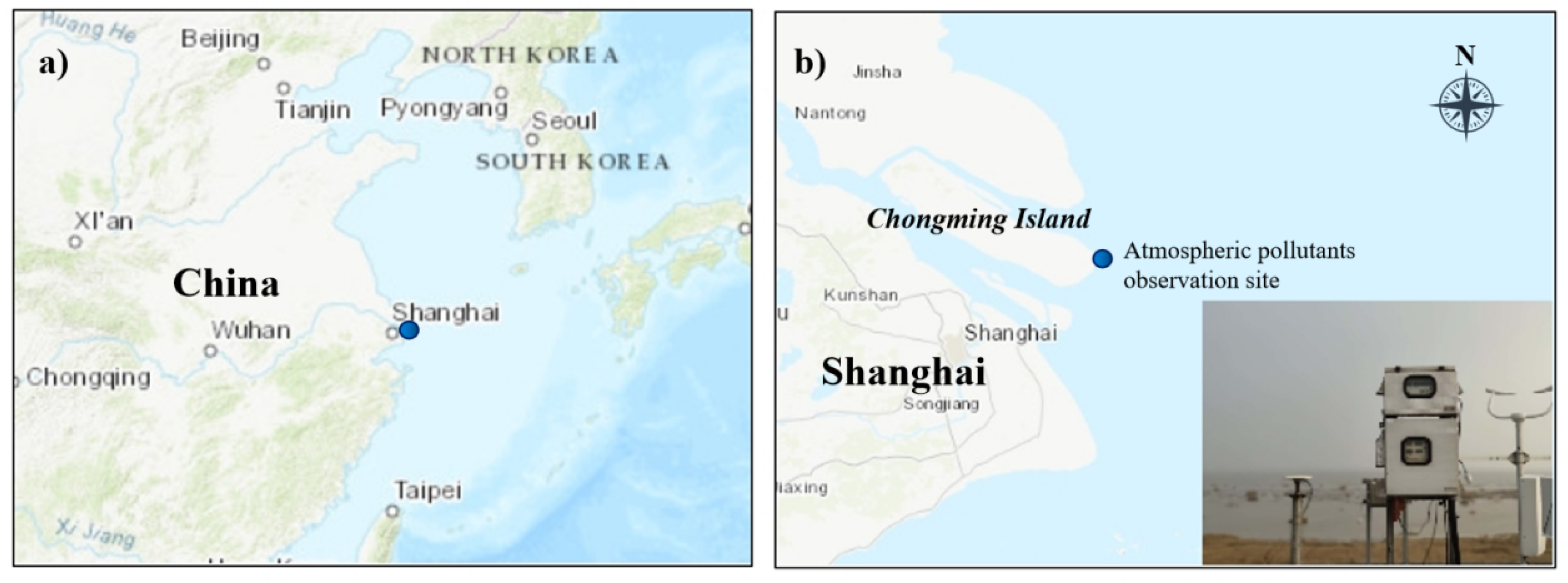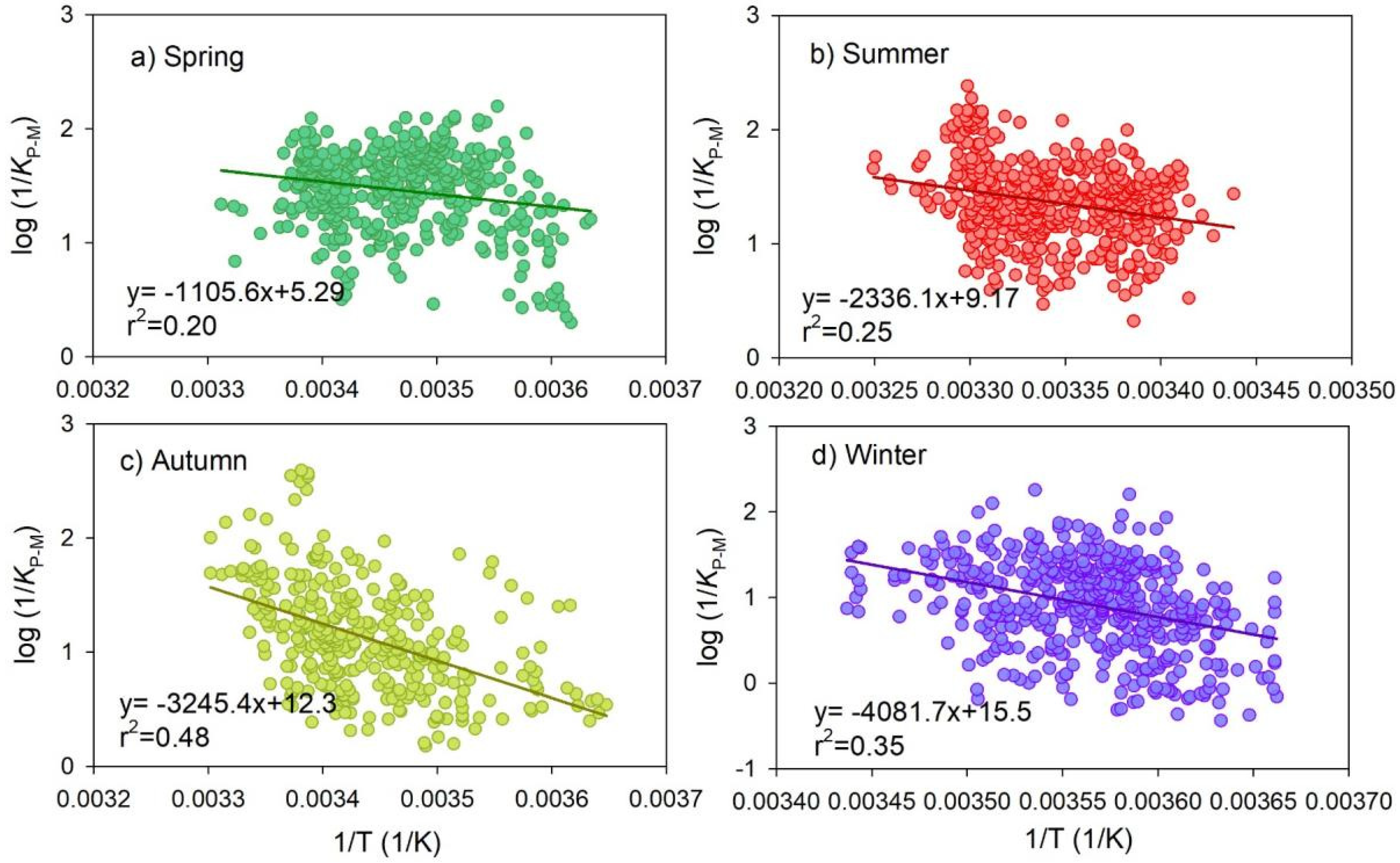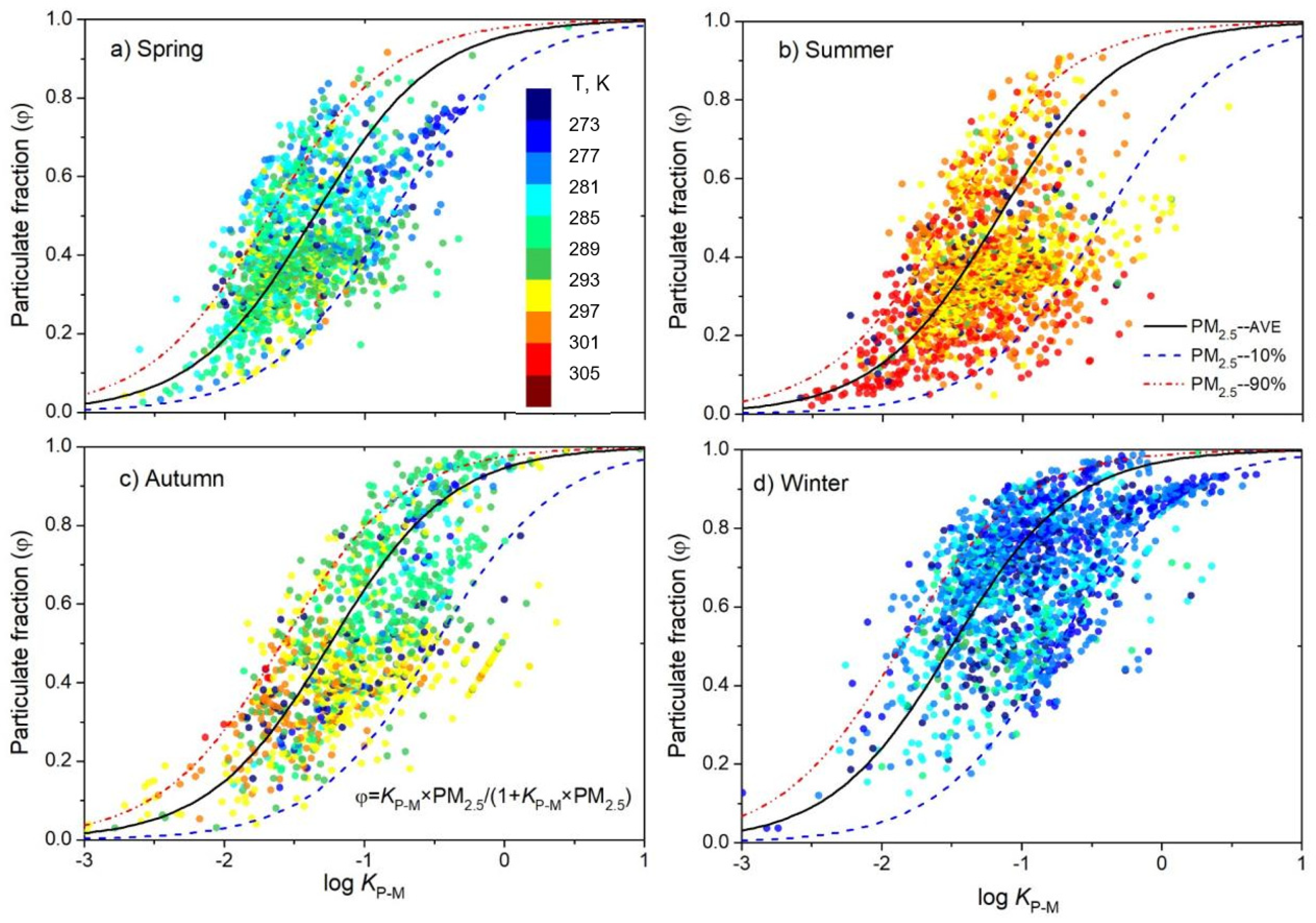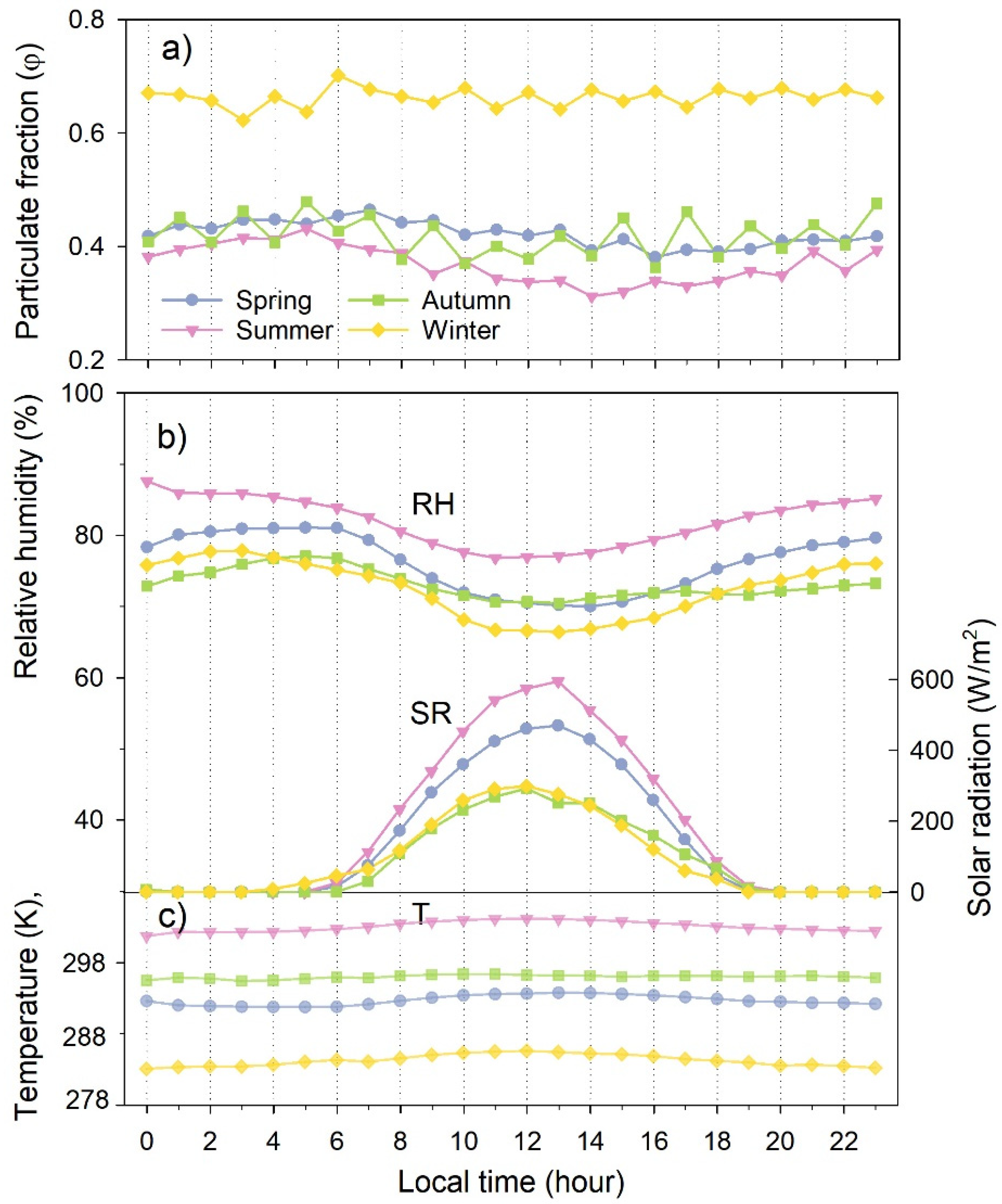Measuring and Regression Modeling of Gas–Particle Partitioning of Atmospheric Oxidized Mercury at a Coastal Site in Shanghai
Abstract
1. Introduction
2. Materials and Methods
2.1. Observation Site
2.2. Atmospheric Mercury, Pollutants and Meteorological Parameters Monitoring
2.3. Gas–Particle Partitioning Model
3. Results
3.1. Concentrations of GEM, RGM and PBM
3.2. Regression of log(1/KP) and 1/T
3.3. Factors Affecting Mercury Gas–Particle Partitioning
3.3.1. Influences from Temperature and PM2.5
3.3.2. Influences from Relative Humidity and Photochemical Reactions
3.4. Limitation and Environmental Implication
4. Conclusions
Author Contributions
Funding
Institutional Review Board Statement
Informed Consent Statement
Data Availability Statement
Acknowledgments
Conflicts of Interest
References
- Lyman, S.N.; Cheng, I.; Gratz, L.E.; Weiss-Penzias, P.; Zhang, L. An updated review of atmospheric mercury. Sci. Total Environ. 2020, 707, 135575. [Google Scholar] [PubMed]
- Amos, H.; Jacob, D.; Holmes, C.; Fisher, J.; Wang, Q.; Yantosca, R.; Corbitt, E.; Galarneau, E.; Rutter, A.; Gustin, M.; et al. Gas–particle partitioning of atmospheric Hg(II) and its effect on global mercury deposition. Atmos. Chem. Phys. 2012, 12, 591–603. [Google Scholar] [CrossRef]
- Tacey, S.A.; Xu, L.; Szilvasi, T.; Schauer, J.J.; Mavrikakis, M. Quantum chemical calculations to determine partitioning coefficients for HgCl2 on iron-oxide aerosols. Sci. Total Environ. 2018, 636, 580–587. [Google Scholar] [CrossRef] [PubMed]
- Shah, V.; Jacob, D.J.; Thackray, C.P.; Wang, X.; Sunderland, E.M.; Dibble, T.S.; Saiz-Lopez, A.; Černušák, I.; Kellö, V.; Castro, P.J.; et al. Improved Mechanistic Model of the Atmospheric Redox Chemistry of Mercury. Environ. Sci. Technol. 2021, 55, 14445–14456. [Google Scholar] [CrossRef] [PubMed]
- Qin, X.; Wang, X.; Shi, Y.; Yu, G.; Zhao, N.; Lin, Y.; Fu, Q.; Wang, D.; Xie, Z.; Deng, C.; et al. Characteristics of atmospheric mercury in a suburban area of east China: Sources, formation mechanisms, and regional transport. Atmos. Chem. Phys. 2019, 19, 5923–5940. [Google Scholar] [CrossRef]
- Cheng, I.; Zhang, L.; Blanchard, P. Regression modeling of gas-particle partition of oxidized mercury from temperature data. J. Geophys. Res. Atmos. 2014, 119, 11864–11876. [Google Scholar] [CrossRef]
- Deng, C.; Tong, Y.; Chen, L.; Yuan, W.; Sun, Y.; Li, J.; Wang, X.; Zhang, W.; Lin, H.; Xie, H.; et al. Impact of particle chemical composition and water content on the photolytic reduction of particle-bound mercury. Atmos. Environ. 2019, 95, 355–362. [Google Scholar] [CrossRef]
- Han, D.; Fu, Q.; Gao, S.; Hu, Z.; Zhang, X.; Chen, X.; Feng, J.; Cheng, J.; Wang, W. Two-year monitoring of gaseous elementary mercury in a typical iron-steel plant in Yangtze River Delta, China: Characterization and estimation of its dynamic oxidation. Sci. Total Environ. 2019, 657, 1217–1226. [Google Scholar] [CrossRef]
- Zhang, K.; Zheng, W.; Sun, R.; He, S.; Shuai, W.; Fan, X.; Yuan, S.; Fu, P.; Deng, J.; Li, X.; et al. Stable Isotopes Reveal Photoreduction of Particle-Bound Mercury Driven by Water-Soluble Organic Carbon during Severe Haze. Environ. Sci. Technol. 2022, 56, 10619–10628. [Google Scholar] [CrossRef]
- Zhang, L.; Wang, L.; Wang, S.; Dou, H.; Li, J.; Li, S.; Hao, J. Characteristics and Sources of Speciated Atmospheric Mercury at a Coastal Site. Aerosol Air Qual. Res. 2017, 17, 2913–2923. [Google Scholar] [CrossRef]
- Tang, Y.; Wang, S.; Wu, Q.; Liu, K.; Wang, L.; Li, S.; Gao, W.; Zhang, L.; Zheng, H.; Li, Z.; et al. Recent decrease trend of atmospheric mercury concentrations in East China: The influence of anthropogenic emissions. Atmos. Chem. Phys. 2018, 18, 8279–8291. [Google Scholar] [CrossRef]
- Rutter, A.P.; Schauer, J.J. The effect of temperature on the gas–particle partitioning of reactive mercury in atmospheric aerosols. Atmos. Environ. 2007, 41, 8647–8657. [Google Scholar] [CrossRef]
- Rutter, A.P.; Schauer, J.J. The Impact of Aerosol Composition on the Particle to Gas Partitioning of Reactive Mercury. Environ. Sci. Technol. 2007, 41, 3934–3939. [Google Scholar] [CrossRef] [PubMed]
- Ma, W.L.; Sun, D.Z.; Shen, W.G.; Yang, M.; Qi, H.; Liu, L.Y.; Shen, J.M.; Li, Y.F. Atmospheric concentrations, sources and gas–particle partitioning of PAHs in Beijing after the 29th Olympic Games. Environ. Pollut. 2011, 159, 1794–1801. [Google Scholar] [CrossRef]
- Xie, M.; Michael, P.H.; Barsanti, K.C. Gas particle partitioning of n-alkanes, PAHs and oxygenated PAHs in urban Denver. Atmos. Environ. 2014, 95, 355–362. [Google Scholar] [CrossRef]
- Tang, Y.; Wang, S.; Li, G.; Han, D.; Liu, K.; Li, Z.; Wu, Q. Elevated Gaseous Oxidized Mercury Revealed by a Newly Developed Speciated Atmospheric Mercury Monitoring System. Environ. Sci. Technol. 2022, 56, 7707–7715. [Google Scholar] [CrossRef]
- Han, D.; Zhang, J.; Hu, Z.; Ma, Y.; Duan, Y.; Han, Y.; Chen, X.; Zhou, Y.; Cheng, J.; Wang, W. Particulate mercury in ambient air in Shanghai, China: Size-specific distribution, gas–particle partitioning, and association with carbonaceous composition. Environ. Pollut. 2018, 238, 543–553. [Google Scholar] [CrossRef]
- Lin, H.; Tong, Y.; Yin, X.; Zhang, Q.; Zhang, H.; Zhang, H.; Chen, L.; Kang, S.; Zhang, W.; Schauer, J.J.; et al. First measurement of atmospheric mercury species in Qomolangma, Tibetan Plateau, and evidence of transboundary pollutant invasion. Atmos. Chem. Phys. 2019, 19, 1373–1391. [Google Scholar] [CrossRef]
- Yin, X.; Kang, S.; Foy, B.D.; Ma, Y.; Tong, Y.; Zhang, W.; Wang, X.; Zhang, G.; Zhang, Q. Multi-year monitoring of atmospheric total gaseous mercury at a remote high-altitude site (Nam Co, 4730m a.s.l.) in the inland Tibetan Plateau region. Atmos. Chem. Phys. 2018, 18, 10557–10574. [Google Scholar] [CrossRef]
- Fu, X.; Feng, X.; Liang, P.; Deliger; Zhang, H.; Ji, J.; Liu, P. Temporal trend and sources of speciated atmospheric mercury at Waliguan GAW station, Northwestern China. Atmos. Chem. Phys. 2012, 12, 1951–1964. [Google Scholar] [CrossRef]
- Brooksa, S.; Lindbergb, S.; Southworthc, G.; Arimoto, R. Springtime atmospheric mercury speciation in the McMurdo, Antarctica coastal region. Atmos. Environ. 2008, 42, 2885–2893. [Google Scholar] [CrossRef]
- Fu, X.; Feng, X.; Qiu, G.; Shang, L.; Zhang, H. Speciated atmospheric mercury and its potential source in Guiyang, China. Atmos. Environ. 2011, 45, 4205–4212. [Google Scholar] [CrossRef]
- Xu, L.; Chen, J.; Yang, L.; Niu, Z.; Tong, L.; Yin, L.; Chen, Y. Characteristics and sources of atmosphe...ation in a coastal city, Xiamen, China. Chmosphere 2015, 119, 530–539. [Google Scholar] [CrossRef] [PubMed]
- Zhang, H.; Wang, Z.; Wang, C.; Zhang, X. Concentrations and gas–particle Concentrations and gas–particle partitioning of atmospheric reactive mercury at an urban site in Beijing, China. Environ. Pollut. 2019, 249, 13–23. [Google Scholar] [CrossRef] [PubMed]
- Sheu, G.-R.; Nguyen, L.S.P.; Truong, M.T.; Lin, D.-W. Characteristics of atmospheric mercury at a suburban site in northern Taiwan and influence of trans-boundary haze events. Atmos. Environ. 2019, 214, 116872. [Google Scholar] [CrossRef]
- Lee, G.-S.; Kim, P.-R.; Han, Y.-J.; Holsen, T.M.; Seo, Y.-S.; Yi, S.-M. Atmospheric speciated mercury concentrations on an island between China and Korea: Sources and transport pathways. Atmos. Chem. Phys. 2016, 16, 4119–4133. [Google Scholar] [CrossRef]
- Ren, X.; Luke, W.T.; Kelley, P.; Cohen, M.D.; Artz, R.; Olson, M.L.; Schmeltz, D.; Puchalski, M.; Goldberg, D.L.; Ring, A.; et al. Atmospheric mercury measurements at a suburban site in the Mid-Atlantic United States_Inter-annual, seasonal and diurnal variations and source-receptor relationships. Atmos. Environ. 2016, 146, 141–152. [Google Scholar] [CrossRef]
- Song, Z.; Sun, R.; Zhang, Y. Modeling mercury isotopic fractionation in the atmosphere. Environ. Pollut. 2022, 307, 119588. [Google Scholar] [CrossRef]
- Gustin, M.; Amos, H.; Huang, J.; Miller, M.; Heidecorn, K. Measuring and modeling mercury in the atmosphere: A critical review. Atmos. Chem. Phys. 2015, 15, 5697–5713. [Google Scholar] [CrossRef]
- Zhang, L.; Zhou, P.; Cao, S.; Zhao, Y. Global deposition of speciated atmospheric mercury to terrestrial surfaces: An overview. Atmos. Chem. Phys. 2019, 19, 15587–15608. [Google Scholar] [CrossRef]





| Observation Site | Type | Sampling Time | GEM | RGM | PBM | Reference |
|---|---|---|---|---|---|---|
| Shanghai, China | Background | March 2014–February 2017 | 2.12 ± 0.94 | 14.75 ± 9.94 | 21.81 ± 30.46 | This study |
| Spring | 2.16 ± 1.04 | 21.31 ± 10.00 | 15.08 ± 13.54 | |||
| Summer | 2.46 ± 1.13 | 16.34 ± 8.31 | 11.45 ± 13.25 | |||
| Autumn | 1.86 ± 0.69 | 14.57 ± 11.46 | 22.26 ± 29.87 | |||
| Winter | 2.06 ± 0.96 | 13.23 ± 9.31 | 42.60 ± 43.22 | |||
| Shanghai, China | Background | 2009–2012 | 2.65 ± 1.73 | 8.0 ± 8.8 | 21.5 ± 25.4 | [10] |
| Shanghai, China | Background | January 2015–May 2016 | 2.77 ± 1.36 | 82.1 ± 115.4 | 60.8 ± 67.4 | [5] |
| Shanghai, China | Urban | March 2017–May 2017 | / | / | 292 ± 121 | [17] |
| Beijing, China | Urban | 2015–2016 | 4.70 ± 3.53 | 18.47 ± 22.27 | 85.18 ± 95.34 | [24] |
| Beijing, China | Urban | September 2021 | 3.02 ± 1.09 | 454 ± 349 | 46 ± 54 | [16] |
| Guiyang, China | Urban | August 2009–October 2009 | 9.72 ± 10.2 | 35.7 ± 43.9 | 368 ± 676 | [22] |
| Xiamen, China | Suburban | March 2012–February 2013 | 3.50 | 61.05 | 174.41 | [23] |
| Qomolangma, China | Remote | April 2016–September 2016 | 1.42 ± 0.37 | 21.4 ± 13.4 | 25.6 ± 19.1 | [18] |
| Nam Co, China | Remote | November 2014–February 2015 | 1.33 ± 0.24 | 0.85 ± 2.91 | 48.69 ± 60.28 | [19] |
| Waliguan, China | Remote | September 2007–September 2008 | 1.98 ± 0.98 | 7.4 ± 4.8 | 19.4 ± 18.1 | [20] |
| Taoyuan, Taiwan, China | Suburban | October 2017–September 2018 | 2.61 ± 6.47 | 12.1 ± 34.3 | 18.7 ± 86.8 | [25] |
| Gyodong, South Korea | Background | August 2015–September 2017 | 2.5 ± 1.5 | 5.0 ± 6.2 | 24.0 ± 28.1 | [26] |
| Beltsville, America | Suburban | 2007–2015 | 1.41 ± 0.23 | 4.6 ± 33.7 | 8.6 ± 56.8 | [27] |
| Ross Island, Antarctica | Remote | October 2003–December 2003 | 1.2 ± 1.08 | 116 ± 45 | 49 ± 36 | [21] |
Publisher’s Note: MDPI stays neutral with regard to jurisdictional claims in published maps and institutional affiliations. |
© 2022 by the authors. Licensee MDPI, Basel, Switzerland. This article is an open access article distributed under the terms and conditions of the Creative Commons Attribution (CC BY) license (https://creativecommons.org/licenses/by/4.0/).
Share and Cite
Han, D.; Wang, S.; Wu, Q.; Tang, Y.; Wen, M. Measuring and Regression Modeling of Gas–Particle Partitioning of Atmospheric Oxidized Mercury at a Coastal Site in Shanghai. Atmosphere 2022, 13, 2014. https://doi.org/10.3390/atmos13122014
Han D, Wang S, Wu Q, Tang Y, Wen M. Measuring and Regression Modeling of Gas–Particle Partitioning of Atmospheric Oxidized Mercury at a Coastal Site in Shanghai. Atmosphere. 2022; 13(12):2014. https://doi.org/10.3390/atmos13122014
Chicago/Turabian StyleHan, Deming, Shuxiao Wang, Qingru Wu, Yi Tang, and Minneng Wen. 2022. "Measuring and Regression Modeling of Gas–Particle Partitioning of Atmospheric Oxidized Mercury at a Coastal Site in Shanghai" Atmosphere 13, no. 12: 2014. https://doi.org/10.3390/atmos13122014
APA StyleHan, D., Wang, S., Wu, Q., Tang, Y., & Wen, M. (2022). Measuring and Regression Modeling of Gas–Particle Partitioning of Atmospheric Oxidized Mercury at a Coastal Site in Shanghai. Atmosphere, 13(12), 2014. https://doi.org/10.3390/atmos13122014









